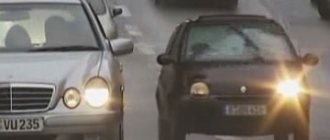2.1. The driver of a motor vehicle is obliged to:
(Article: 2.1. The driver of a motor vehicle is obliged:)
2.1.1. Carry with you and, at the request of police officers, hand over to them for inspection:
- a driver’s license for the right to drive a vehicle of the appropriate category, and in case of withdrawal of a driver’s license in accordance with the established procedure - a temporary permit;
- registration documents and a certificate of passing state technical inspection for this vehicle, and if there is a trailer, also for the trailer;
- a document confirming the right to own, or use, or dispose of this vehicle, and if there is a trailer, also for the trailer, in the case of driving the vehicle in the absence of its owner;
- in established cases, a waybill, a license card and documents for the transported cargo, and when transporting large, heavy and dangerous goods - documents provided for by the rules for the carriage of these goods;
- insurance policy of compulsory civil liability insurance of the vehicle owner in cases where the obligation to insure one’s civil liability is established by federal law.
In cases expressly provided for by current legislation, have and submit for inspection to employees of the Federal Service for Supervision of Transport a license card, waybill and shipping documents.
2.1.2. When driving a vehicle equipped with seat belts, be fastened and do not carry passengers who are not wearing seat belts.
Traffic lights and traffic controller signals
Traffic light
cancels the actions of priority signs, but does not cancel the indication of signs prescribing the direction of movement, and
the traffic controller
can cancel the instructions of the traffic light, any road signs and markings, but do not forget that traffic on the lanes must comply with
the Rules for driving through intersections
.
If there is no traffic light or traffic controller, look at the signs or markings
.
Signs are more important than markings, and a temporary sign is more important than a permanent sign.
Read more here
2.3. The driver of the vehicle is obliged to:
(Article: 2.3. The driver of the vehicle is obliged:)
2.3.1. Before leaving, check and ensure that the vehicle is in good technical condition on the way in accordance with the “Basic provisions for the admission of vehicles to operation and the responsibilities of officials to ensure road safety” (hereinafter referred to as the “Basic Provisions”).
It is prohibited to drive if there is a malfunction of the service brake system, steering control, coupling device (as part of a train), headlights and tail lights are not on (missing) in the dark or in conditions of insufficient visibility, the windshield wiper is not working on the driver’s side during rain or snowfall.
If other malfunctions occur along the way, for which the operation of vehicles is prohibited by the appendix to the Basic Provisions, the driver must eliminate them, and if this is not possible, then he can proceed to the place of parking or repair in compliance with the necessary precautions;
2.3.2. At the request of officials who are granted the right of state supervision and control over road safety and vehicle operation, undergo an examination for alcohol intoxication and a medical examination for intoxication. The driver of a vehicle of the Armed Forces of the Russian Federation, internal troops of the Ministry of Internal Affairs of the Russian Federation, civil defense troops, engineering, technical and road construction military formations under federal executive authorities is required to undergo an examination for alcohol intoxication and a medical examination for intoxication, also at the request of officials military automobile inspection.
In established cases, undergo a test of knowledge of the Rules and driving skills, as well as a medical examination to confirm the ability to drive vehicles.
2.3.3. Provide a vehicle:
- employees of the police, federal state security agencies and federal security service agencies in cases provided for by law;
- medical and pharmaceutical workers to transport citizens to the nearest medical facility in cases that threaten their lives.
Note. Persons using a vehicle must, at the request of the driver, issue him a certificate of the established form or make an entry in the waybill (indicating the duration of the trip, distance traveled, his last name, position, service ID number, name of his organization), and medical and pharmaceutical workers - issue a coupon of the established form.
At the request of vehicle owners, federal state security authorities and federal security service authorities shall compensate them in accordance with the established procedure for losses, expenses, or damage in accordance with the law.
2.5. In the event of a traffic accident, the driver involved in it is obliged to:
(Article: 2.5. In case of a traffic accident, the driver involved in it is obliged:)
- immediately stop (do not move) the vehicle, turn on the hazard warning lights and display an emergency stop sign in accordance with the requirements of paragraph 7.2 of the Rules, do not move objects related to the incident;
- take measures to provide first aid to the victims, call an ambulance, and in emergency cases, send the victims on a passing one, and if this is not possible, deliver them in your vehicle to the nearest medical facility, provide your last name, vehicle registration plate (with presentation identification document or driver's license and vehicle registration document) and return to the scene of the incident.
- clear the roadway if the movement of other vehicles is impossible. If it is necessary to clear the roadway or deliver victims in your vehicle to a medical facility, first record in the presence of witnesses the position of the vehicle, traces and objects related to the incident, and take all possible measures to preserve them and organize a detour to the scene of the incident;
- report the incident to the police, write down the names and addresses of eyewitnesses and wait for the arrival of police officers.
General provisions
First of all, it is enough to know that in Russia there is right-hand traffic and you can only move on the extreme right side of the road, and use your eye to determine the width of the roadway. The first step is to divide the road
in half and know your lane for traffic; the lane width according to GOST should be from 2.5 to 4 meters. The right of way for traffic is given to those who have their own lane free or are on the main road.
Read more here
2.7. The driver is prohibited from:
(Article: 2.7. The driver is prohibited from:)
- drive a vehicle while intoxicated (alcohol, drugs or other), under the influence of medications that impair reaction and attention, in a sick or tired state that jeopardizes traffic safety;
- transfer control of a vehicle to persons who are intoxicated, under the influence of medications that impair reaction and attention, in a sick or tired state, as well as to persons who do not have a driver’s license to drive a vehicle of this category or - in case of its seizure in accordance with the established procedure - a temporary permit, except for cases of driving lessons in accordance with section 21 of the Rules;
- cross organized (including foot) columns and take a place in them;
- consume alcoholic beverages, narcotic, psychotropic or other intoxicating substances after a traffic accident in which he is involved, or after the vehicle was stopped at the request of a police officer, before an examination to establish the state of intoxication or before a decision on release is made from carrying out such an examination;
- drive a vehicle in violation of the work and rest regime established by the authorized federal executive body, and when carrying out international road transport - by international treaties of the Russian Federation;
- use while driving a telephone that is not equipped with a technical device that allows hands-free conversations.
Every day we go out or go out onto the streets, move in one direction or another by car, bicycle, public transport or on foot. In any case, you need to know and follow the rules of the road so as not to endanger yourself and other people on the road.
In conditions of heavy traffic, the number of road accidents involving minors increases.
We bring to your attention a thematic lesson (class hour) “Compliance with traffic rules - the path to personal safety” for students in grades 5–7. This lesson will help students learn traffic rules and master safe behavior skills on the streets and roads of the city, will contribute to the acquisition of knowledge and skills to protect life and health in dangerous road situations, and will teach how to create a safe route “Home - school - home”.
Authors: T. V. Subbotina, V. G. Zubkov
Recommendations for working with the presentation of the thematic lesson (class hour) “Compliance with traffic rules - the path to personal safety” for students in grades 5–7
Lesson option [PDF] [DOCX]
Presentation [PDF] [PPTX]
Student assignments [PDF] [DOCX]
Additional material for teachers [PDF] [DOCX]
Goal: creating a culture of safe behavior on the roads.
Tasks:
- to form in children an understanding that traffic rules are the law for all road users;
- teach children to navigate the “Rules of the Road”;
- form a clear idea of pedestrian discipline;
- to form in children a negative attitude towards violators of traffic norms and rules;
- teach how to create a safe route “Home - school - home”.
Equipment: multimedia equipment, laptop, tablet; sheets with diagrams of the territory of the district where the educational organization is located; felt-tip pens, colored pencils.
The methodological material is of a recommendatory nature. Taking into account the characteristics of each class, the teacher can vary the tasks, their number and stages of the lesson.
For reference:
Road accidents are one of the serious problems in our society, and it is believed that one of the reasons for this problem is the lack of culture of road users: their lack of discipline and non-compliance with traffic rules.
Question:
How do you think traffic rules and personal safety are related?
Based on the students’ answers, the class teacher formulates the purpose and objectives of the class hour.
Questions:
- What do you know about traffic rules?
- Why do you need to know and follow these rules?
- Who are road users?
The teacher determines the level of children's knowledge of traffic rules and comments on the students' answers.
The teacher talks about the Traffic Rules of the Russian Federation, focusing in more detail on the section “Responsibilities of Pedestrians” (see “Additional Material for Teachers”).
Exercise:
Look at the slide and explain the rule for crossing the road.
Questions:
- What is a crossroads?
- Why is an intersection dangerous for pedestrians?
- What rules must be followed when crossing an intersection?
Questions:
- What do traffic lights mean?
- What does a flashing yellow traffic light signal indicate?
- How to cross the street if the traffic light is flashing yellow?
Question:
- Why do you have to look when crossing the roadway, turning your head to the right and left, even if there are no cars on the road at the moment?
Question:
- Why can't you play on the road or near the road?
(You can hold a competition among students: name the greatest number of reasons why you can’t play on the road.)
Discussion of the situation:
- What is the danger of the situation depicted on the slide?
- What traffic rules were violated?
Question:
- What is the danger of the situation depicted on the slide?
Question:
- Why can't you walk on the roadway?
Assignment for students:
The slide names only one of the reasons why children get into accidents at stops more often than at intersections. Give other examples.
Exercise:
The class is divided into three groups. Each group receives the task of working with the rules of behavior for pedestrians and drawing up a safe route “Home - school - home”. To complete the task, the groups are given sheets with diagrams of the territory of the district of the educational organization.
Each route being developed can be discussed in class, where a group of students - the developers of the route sheet - must explain its content.
The class teacher talks about recommendations for developing a route sheet, which combines diagrams and descriptions of the route of schoolchildren from home to school and back.
The main goal of the route sheet is to improve the student’s traffic safety and teach him how to navigate traffic situations.
Having chosen a movement option, students plot it on a map of the streets from home to school.
The class teacher draws the attention of students to the fact that if the route includes a trip by public transport, then the diagram should show the location of the streets near the house (place of boarding public transport) and the location of the streets near the school (place of exit from public transport and movement to school ).
Students, while completing the task, highlight areas of increased danger on the diagram.
This is usually:
- leaving the house and crossing the street for the first time;
- crossing streets and intersections;
- boarding and exiting public transport (stop).
Areas of increased danger on non-recommended travel options are highlighted to explain why they are dangerous and why they are not recommended.
The class teacher draws the attention of schoolchildren to the description in the route of crossing the street if it is not regulated by a traffic light.
The class teacher draws the students' attention to the description in the route of crossing the street if it is regulated by a traffic light.
Students, working in groups, discuss the characteristics of the streets along which they walk to school.
Students remember the rules for boarding public transport, if necessary, enter this information into the route sheet.
Students remember the rules for exiting public transport and, if necessary, enter this information into the route sheet.
At the end of the group work, they are asked to think and answer the question “What should I title this slide?”
(You can hold a competition for the best slide title.)
At the final stage of the class hour, situational problems are considered for reflection (application). Students receive individual assignments. These can be text or test tasks (application).
The class teacher sums up the class hour.
Travel speed
(Article: 10. Movement speed)
10.1. The driver must drive the vehicle at a speed not exceeding the established limit, taking into account the intensity of traffic, the characteristics and condition of the vehicle and cargo, road and meteorological conditions, in particular visibility in the direction of travel. If a traffic hazard arises that the driver is able to detect, he must take possible measures to reduce the speed until the vehicle stops.
10.2. In populated areas, vehicles are allowed to move at a speed of no more than 60 km/h, and in residential areas and courtyard areas no more than 20 km/h.
10.3. Movement outside populated areas is permitted:
- for cars and trucks with a permissible maximum weight of no more than 3.5 tons on highways - at a speed of no more than 130 km/h, on other roads - no more than 90 km/h.
Driving through intersections
If you have practical driving
relatively normal, you just have to be careful not to interfere with those moving on the right, because they always have the advantage. The “right hand” advantage operates where there are no traffic lights, signs, markings, or other indicators that directly regulate traffic.
When approaching an intersection, look at the signs and be prepared to change lanes in advance. It is advisable to choose the route in advance.
When turning left, give way to oncoming people. Always and everywhere give way to pedestrians.
Read more here



